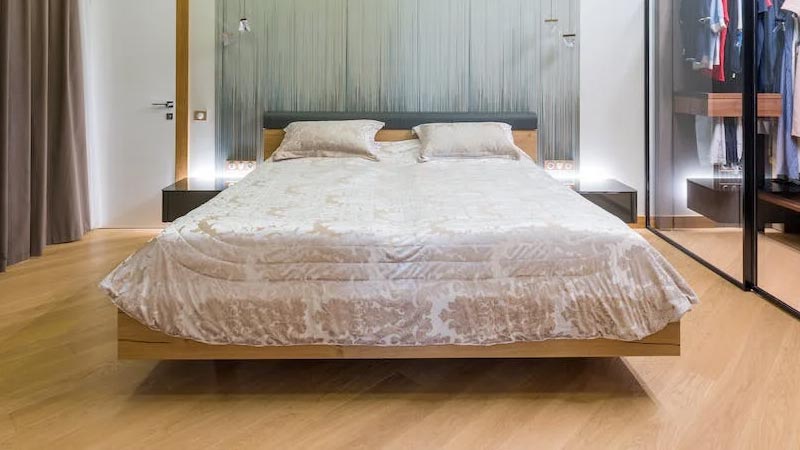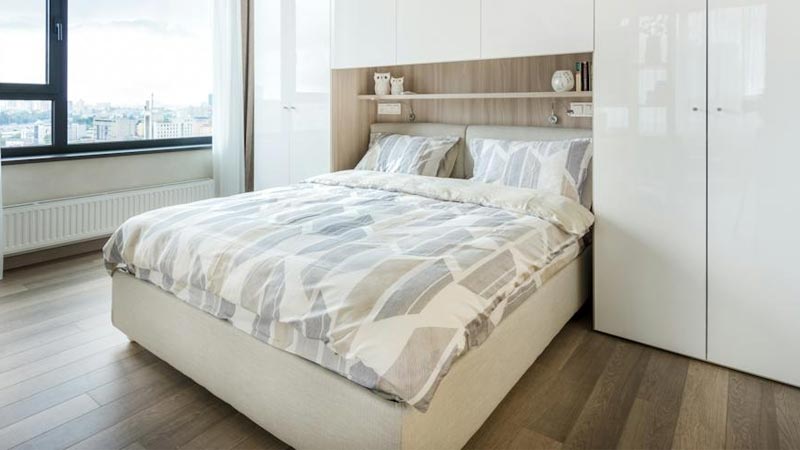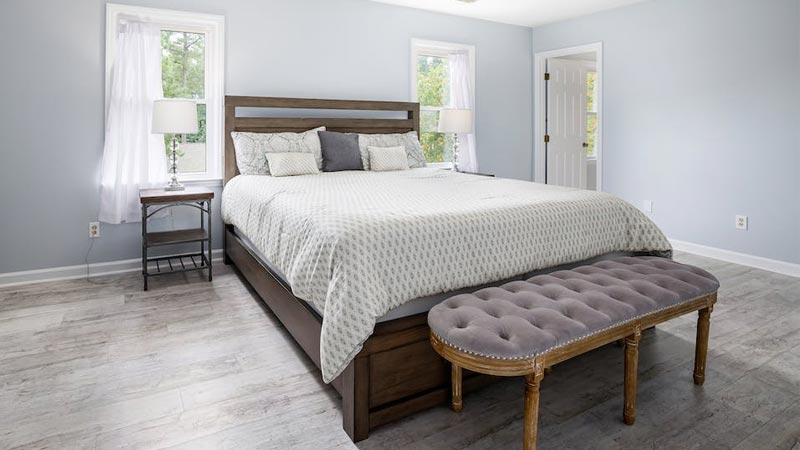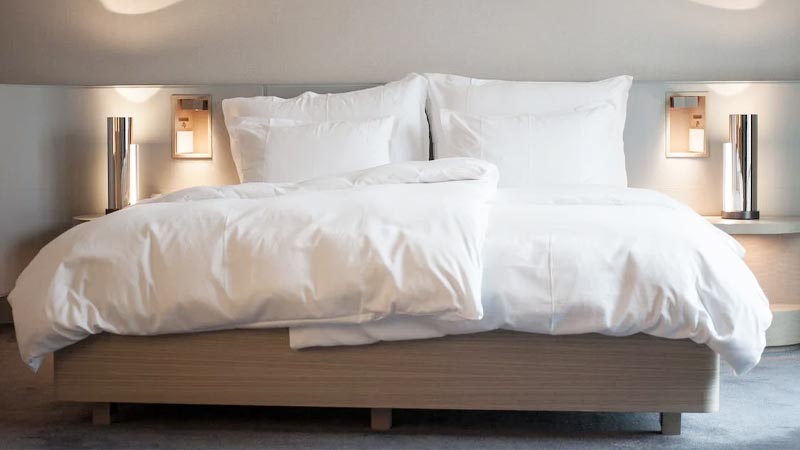Creating a split-corner bedspread is a craft that combines both functionality and aesthetics. Tailored specifically for beds with footboards, this bedspread provides a refined and polished look while allowing convenient access to the bed.
With the right materials and a bit of sewing know-how, you can craft a bedspread that perfectly complements your bedroom decor.
This guide will walk you through the step-by-step process, from selecting the ideal fabric to adding those final decorative touches.
Whether you’re a seasoned seamstress or a beginner looking for a rewarding project, making a split-corner bedspread offers a satisfying way to enhance your bedroom’s ambiance.

What Is a Split Corner Bedspread?
A split corner bedspread is a type of bed covering that is designed specifically for beds with a footboard.
It is tailored to fit neatly around the corners of the mattress and then has two triangular flaps or “splits” at the bottom corners that allow it to drape neatly around the footboard.
This design provides a polished and custom look to the bed while still allowing easy access.
The split corners are essentially openings that accommodate the corners of the footboard, allowing the bedspread to be placed on the bed without needing to lift or remove the footboard.
This makes it a convenient choice for beds with this frame type, which is common in many traditional and classic bed designs.
How to Make a Split Corner Bedspread?
Making a split-corner bedspread is a wonderful way to add a touch of elegance and charm to your bedroom decor.
This type of bedspread is designed to accommodate bed frames with footboards, making it a perfect choice for those who want their bed linens to fit neatly around the entire bed.
Here’s a step-by-step guide on how to make a split-corner bedspread:
Materials You’ll Need:
- Fabric.
- Sewing Machine.
- Thread.
- Measuring Tools.
- Iron and Ironing Board.
Steps to Make a Split Corner Bedspread:
Measure Your Bed
Before you start cutting fabric, ensure you have accurate measurements. Measure the length, width, and height of your mattress.
Add this drop length to your measurements when you want the bedspread to hang down the sides and foot. For split corners, measure the width of your bed frame, including the footboard.
Cut the Fabric
Lay out your chosen fabric on a flat, clean surface. Using your measurements, carefully cut two pieces of fabric – one for the top and one for the bottom.
Ensure you account for seam allowances. If your fabric has a pattern or a specific direction, be mindful of the orientation.
Create the Split Corners
Cut two triangular pieces of fabric for each corner. These triangles will be sewn onto the corners of the top piece to form the split corners.
Measure the width of your bed frame and add seam allowances. Align the triangles to the corners of the top piece, right sides together. Pin them in place.
Sew the Split Corners
Using your sewing machine, stitch along the edges of the triangular pieces onto the corners of the top fabric piece. Start at the top edge of the triangular piece and sew down towards the point.
This will securely attach the split corner and ensure it holds up over time. Backstitch at the beginning and end of your stitching to reinforce the corners.
Sew the Top and Bottom Pieces Together
Place the top and bottom fabric pieces on the right sides together, ensuring all edges are aligned. Pin them together, leaving an opening (about 12 inches wide) along one side.
This opening will be used later to turn the bedspread right side out. Stitch around the edges using a straight stitch.
Turn the Bedspread Right Side Out
Carefully turn the bedspread right side out through the opening you left. Take your time with this step to avoid tearing or misaligning the fabric.
Use a blunt tool, like a chopstick or a knitting needle, to gently push out the corners. This will give your bedspread a clean, crisp look.
Close the Opening
To close the opening in the bedspread, thread your needle with a thread color that matches your fabric. Use a slip stitch or a ladder stitch to join the edges together invisibly.
Start by hiding the knot inside the fold of the fabric. Then, take small, even stitches along the edges, catching both sides of the opening. Pull the thread snugly but not too tight to avoid puckering the fabric.
Press and Finish
Heat up your iron and set it to the appropriate temperature for your fabric. Iron the bedspread to remove any wrinkles and create a smooth, polished finish. Pay special attention to the split corners, making sure they lie flat.
Dress Your Bed
With your split corner bedspread complete, place it on your bed. Make sure the split corners fit snugly around your bed frame and footboard. Arrange your pillows and any additional bedding to complete the look.
What Kind of Fabric Should You Use for Your Split Corner Bedspread?

The choice of fabric for your split corner bedspread depends on your personal preferences, the style of your bedroom, and your desired level of comfort.
Here are some common fabric options and their characteristics:
Cotton
Cotton is a popular choice for bedspreads due to its breathability and comfort. It’s lightweight, easy to care for, and suitable for all seasons. It’s available in various colors and patterns, making it a versatile option for various bedroom styles.
Linen
Linen has a natural, rustic look and is highly breathable, making it ideal for warmer climates. It’s known for its durability and tends to soften over time. Linen bedspreads can add a touch of understated elegance to your bedroom.
Silk
Silk bedspreads exude luxury and sophistication. They have a smooth, soft texture that feels cool against the skin. However, silk can be more delicate and may require special care during washing.
Polyester
Polyester bedspreads are often chosen for their durability, affordability, and wrinkle resistance. They come in various styles and can mimic the look of natural fabrics like cotton and silk.
Velvet
Velvet bedspreads add a rich, opulent texture to your bed. They’re incredibly soft and luxurious, providing warmth and comfort, especially in colder seasons.
Jacquard
Jacquard fabrics feature intricate patterns woven into the material. They can add a touch of elegance and visual interest to your bedspread. Jacquard bedspreads often combine different types of fibers, such as cotton, silk, or synthetic blends.
Microfiber
Microfiber is a synthetic fabric known for its softness, durability, and staining resistance. It’s a practical choice for those seeking a low-maintenance option that still offers comfort.
Benefits of Using a Split Corner Bedspread

Using a split corner bedspread offers several benefits, making it a popular choice for beds with footboards.
Here are some of the advantages:
Tailored Appearance
A split corner bedspread provides a polished and custom look to the bed. It drapes neatly around the footboard, giving the bed a finished and refined appearance.
Easy Installation
The split corners of the bedspread allow it to be easily placed on the bed without the need to lift or remove the footboard. This makes it a convenient option for beds with this type of frame.
Convenience for Footboard Beds
When you have a bed with a footboard, a split corner bedspread is specifically designed to accommodate this feature. It saves you the trouble of maneuvering the bedspread around the footboard, making the bed-making process more straightforward.
Prevents Bunching or Wrinkling
Because the bedspread is designed to fit snugly around the mattress corners and footboard, it’s less likely to bunch up or wrinkle. This ensures that your bed looks tidy and well-kept.
Versatile Style Options
Split corner bedspreads come in various styles, colors, and fabrics. This means you can easily find one that complements your bedroom decor and personal taste.
Allows Access to Under-Bed Storage
For beds with built-in storage drawers or compartments under the mattress, a split corner bedspread allows easy access without lifting the entire bedspread.
Prevents Slipping or Shifting
The tailored fit of a split corner bedspread is particularly effective at keeping it in place on the bed.
Unlike regular bedspreads that can sometimes slide or shift during the night, the split corners provide a secure anchor, ensuring that the bedspread stays neatly in position
Provides Additional Warmth and Comfort
A bedspread can be a valuable addition in colder climates or during the winter months.
It adds an extra layer of insulation, providing warmth and comfort when snuggled up in bed. This is especially appreciated on chilly nights, making your bed cozy.
Protects Bedding and Mattress
Many modern bed frames have built-in storage options like drawers or compartments beneath the mattress.
A split corner bedspread allows you to easily access these storage areas without lifting or moving the entire bedspread. This practical feature is especially handy for those using the under-bed space for linens, clothing, or other items.
Proper Washing Instructions for the Bedspread

Your bedspread is a beautiful addition to your bedroom decor and a cozy and functional piece of bedding that requires proper care to maintain its appearance and longevity.
Here are some essential washing instructions to keep your bedspread clean and pristine:
Check the Care Label
Before washing, carefully read the care label on your bedspread. It will provide specific instructions regarding washing, drying, and any special precautions to take. Some fabrics may require special care, such as dry cleaning or hand washing.
Pre-Treat Stains
When you notice any stains or spots on the bedspread, it’s crucial to address them before washing.
Use a gentle stain remover, mild detergent, and a soft brush or cloth to work on the stain gently. Test the stain remover on an inconspicuous area first to ensure it doesn’t damage the fabric.
Separate Colors
When your bedspread features multiple colors or patterns, washing it separately or with similar colors is advisable. This helps prevent any potential color bleeding, which could lead to fading or discoloration.
Use a Mild Detergent
Choose a mild detergent that is specifically designed for delicate fabrics. Avoid using harsh chemicals or bleach, as they can weaken the fabric fibers and cause them to deteriorate over time.
Use a Gentle Cycle
Set your washing machine to a gentle cycle with cold water. This will minimize any unnecessary stress on the fabric, helping to preserve its texture and color.
Avoid Overloading the Machine
Ensure that the machine is not overloaded. This allows the bedspread to move freely in the water, ensuring a thorough cleaning without causing any unnecessary strain on the fabric.
Turn Inside Out
When your bedspread has a delicate or decorative side, consider turning it inside out before washing it. This precaution helps protect the surface from snags or abrasions during washing.
Wash on a Short Cycle
Opt for the shortest washing cycle available on your machine. This reduces the amount of time your bedspread spends in the water, which is particularly important for delicate fabrics that may be prone to damage over extended exposure.
Rinse Thoroughly
After the wash cycle is complete, make sure to rinse the bedspread thoroughly. Any residue of detergent can lead to discomfort or stiffness in the fabric.
Drying
To prevent shrinkage and damage to delicate fabrics, refrain from using a high heat setting in the dryer.
Opt for a low-heat or air-dry setting instead. Once the cycle is complete, remove the bedspread while it’s still slightly damp to minimize wrinkles, and then carefully reshape it on the bed.
Avoid Aggressive Drying Methods
It’s important to avoid wringing or twisting the bedspread, as this can cause undue stress on the fabric.
Instead, gently squeeze out excess water and then either let it air dry or use a low-heat setting in the dryer. Adding dryer balls can help fluff the fabric.
Tips for Maintaining Its Appearance and Longevity

Maintaining the appearance and longevity of your bedspread is essential to ensure it continues to enhance the aesthetics of your bedroom.
Here are some valuable tips to help you keep your bedspread in top condition:
Regular Shake and Beat
To keep your bedspread looking fresh between washes, make it a habit to shake or beat it gently. This simple action can help dislodge dust and debris, preventing them from settling into the fabric.
Lint Removal
Invest in a lint roller or brush when your bedspread tends to attract lint or pet hair. Regularly using these tools will help you keep the fabric free from unsightly particles.
Gentle Spot Cleaning
For minor stains or spills, spot cleaning is your best friend. Use a mild detergent or a stain remover appropriate for the fabric type.
Before applying any cleaning product, test it on an inconspicuous area of the bedspread to ensure it won’t cause damage or discoloration.
Gently blot the stain with a clean, damp cloth or sponge, working from the outside in, and allow it to air dry thoroughly.
Mindful Machine Washing
When your bedspread is machine washable, follow the care label instructions closely. Use a gentle cycle with cold water and a mild detergent.
Place the bedspread inside a large laundry bag or pillowcase with a zipper to prevent tangling or damage during the wash. Wash it separately from other items to avoid snags or color transfer.
Delicate Drying
When it comes to drying, steer clear of high heat settings, which can cause shrinkage and fabric damage. Instead, opt for a low-heat setting or air-drying.
Remove the bedspread from the dryer while it’s still slightly damp to minimize wrinkles, and then reshape it on the bed.
Ironing Precautions
When ironing is necessary, select a low to medium heat setting and iron the bedspread on the reverse side. This approach helps protect any embellishments or decorative elements from potential damage.
Thoughtful Storage
Proper storage is crucial to prevent damage and maintain the bedspread’s appearance. Store it in a cool, dry location away from direct sunlight to prevent fading.
Consider using a breathable storage bag or cover to shield it from dust and potential insect damage. Avoid hanging the bedspread for extended periods, as this can lead to stretching and distortion.
FAQs
What is a split-corner bedspread?
A split corner bedspread is a type of bed covering designed for beds with a footboard.
What materials do I need to make a split-corner bedspread?
You will need fabric (of your choice), measuring tape, a sewing machine (or needle and thread), pins, scissors, an iron, and potentially a bedspread lining for added weight and structure.
Can I wash a split-corner bedspread in a washing machine?
Yes, you can. However, following the care instructions on the fabric label is important. Generally, use a gentle cycle with cold water and mild detergent.
Can I add embellishments or trim to my bedspread?
You can customize your bedspread with embellishments like embroidery, lace, or trim for a personalized touch.
Do I need to iron the bedspread after washing?
Ironing the bedspread on a low heat setting after washing is recommended to remove wrinkles and ensure a smooth finish.
Wrap Up
In crafting a split corner bedspread, you’ve embarked on a journey to elevate your bedroom’s functionality and elegance.
Following the meticulous steps outlined in this guide, you’ve learned to select the right fabric, measure with precision, and sew carefully.
The result? A tailored masterpiece that complements your bed’s unique design. The split corner bedspread showcases your craftsmanship and exemplifies practicality, allowing easy access to the bed while maintaining a refined appearance.
As you place this creation in your bedroom, take pride that you’ve woven together artistry and practicality to enhance your living space.
Leave a Reply